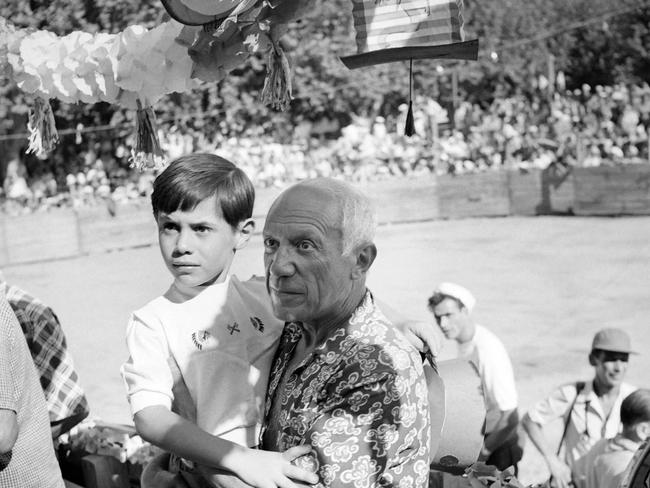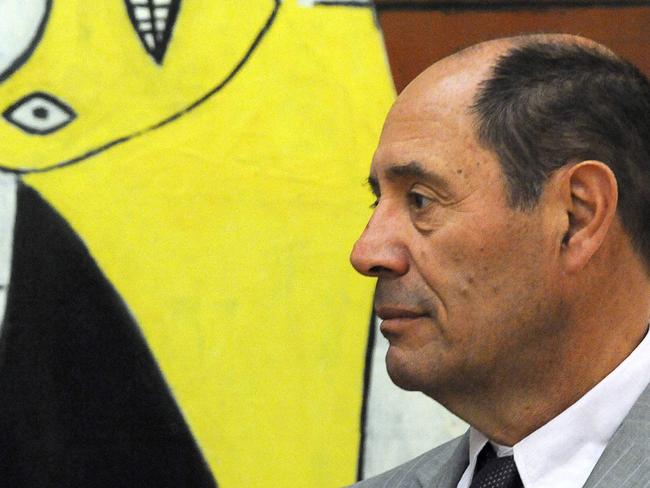Claude Picasso, son of Pablo Picasso, dies in Geneva at age 76
Claude Picasso made a career out of his father’s legacy and messy inheritance.

When Pablo Picasso died in 1973, aged 91, he left more than 45,000 artworks, including sculptures, paintings, drawings and sketchbooks. “We’d have to rent the Empire State Building to house it all,” his son, Claude, declared when the inventory was finished.
A photographer and filmmaker by profession, Claude was appointed by the French courts to manage his father’s estate. The third of the artist’s four children by three women, he created the Picasso Administration in 1996 to control the rights to exhibitions, reproductions and merchandising. At one point, he infuriated photographer Henri Cartier-Bresson, a friend of his father, by lending the Picasso name to Citroen cars.
With his dark eyes and compact build, Claude may not have looked exactly like his father, but the resemblance was there. At first critics complained that neither he nor his relations were art scholars, claiming they were slow to respond to requests from the art world and tardy in publishing a comprehensive catalogue. Claude insisted he had been immersed in his father’s work since birth. “The heirs have decided not to publish for the time being a catalogue raisonne as objects surface still which were not catalogued,” he told Vanity Fair in 2016.
Gradually he earned respect for his thorough and reliable management of his father’s legacy. “He is a good manager, has good assistants, and can, at times, be a tough manager,” one dealer told the magazine. “You have to be tough because today’s art world is a tough business.”
Claude Pierre Pablo Picasso was born in Boulogne-Billancourt in the west of Paris in 1947, the son of Pablo Picasso and Francoise Gilot, the only lover to voluntarily have left the artist. He had a younger sister, Paloma, a jewellery designer to whom he handed responsibility for the Picasso Administration in July. Being born out of wedlock, the siblings had to fight in the French courts to be recognised as their father’s children.

Picasso’s eldest son, Paul, from his marriage to ballet dancer Olga Khokhlova, died in 1975, and his eldest daughter, Maya, whose mother was French model Marie-Therese Walter, died last year.
Claude’s mother recalled his childhood in her memoir, Life with Picasso (1964), which the artist tried to have banned. “For Claude, toys were not something to play with. From the age of three, whenever a new toy came into the house, he would take a hammer and go to work on it,” she wrote.
Claude remembered how artist Henri Matisse was a grandfather-like figure. “He used to call me ‘My little Hercules’ because I would move everything around in his room,” he said. “I was very enamoured with Matisse and my father was very, very annoyed about it – mostly because whenever I did a little doodle or drawing, I would sign it ‘Henri Matisse’.”
Father and son sometimes watched Spanish matador El Cordobes in action, though afterwards Claude complained that he had adopted an unconventional approach, not even killing the bull properly. “My father said, ‘What are you saying? You should like him … What would ever have happened if I’d painted like Delacroix?’”
On one occasion the teenage Claude borrowed his father’s car and almost ran over their neighbour, painter Max Ernst, who was crossing the street.
After Gilot’s memoir was published, Picasso refused to have anything to do with their children. “One of my greatest heartbreaks as a child was the day I slipped away from my mother’s house and went to try to see my father,” Claude recalled. “I saw him standing at the window … Without a wave or any other gesture to me he directed one of the servants to come out and throw me back over the wall.”
He moved to New York in 1967, finding work with Richard Avedon, who had photographed him and Paloma as children. He studied at the Actors Studio, made a documentary about sculptor Richard Serra and designed carpets.

On weekends he hung out in the Hamptons, enjoying picnics and football. “Nobody knew how to play,” he laughed. “It was probably just an excuse to get drunk and have fun.”
In 1969 he married Sara Lavner, who became a drama therapist and psychoanalyst. The marriage was dissolved three years later and in 1979 he married Sydney Russel, who writes about art. That was dissolved in 1990 and he is survived by his third wife, Sylvie (nee Vautier), and by two sons, Jasmin and Solal.
He also worked for several American publications, including Life magazine, which sent him to London to photograph the Incredible String Band, a psychedelic folk group. “They lived as a commune in Wales, they lived with the animals and were very laid-back, really hardcore hippies,” he recalled.
In contrast he also photographed Dutch artist Willem de Kooning on his post-war return to The Netherlands, recalling: “De Kooning was very proper and wore a tie and we went around to all the museums and met up with a friend from his youth in Rotterdam, and I just kept shooting.”
Claude was president of Spadem, the French artists’ rights association. When his father died without leaving a will, he and 19 lawyers became embroiled in unravelling the mess, a task that increasingly overtook his photography.
“I stopped because I couldn’t work professionally any more, I was too busy with the estate and running the Picasso Administration,” he told John Richardson, Picasso’s biographer, in Gagosian Quarterly.
He became involved in motor racing after photographer David Douglas Duncan confided that he was going to sell his rare Mercedes Gullwing: “I said, ‘It’s your old horse. You can’t just throw him out of the house’.” When Duncan insisted, Claude bought it, taking part in up to a dozen vintage car races a year. He specialised in races through the desert of Morocco or on snow and ice in Finland. “Quite dangerous, actually, but I became very good at these difficult races,” he said.
Yet his life continued to revolve around his father’s legacy, which somehow had become a career. “I really thought I should do my own thing, as Paloma does,” he once sighed. “Sometimes I wonder what the hell I am doing. There’s something very emotionally complicated about it.”
The Times
Claude Picasso, photographer and administrator of the Pablo Picasso estate. Born Paris, May 15, 1947. Died Geneva, August 24, aged 76.
